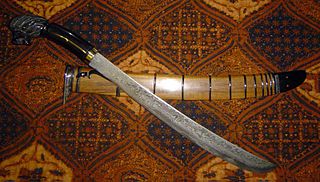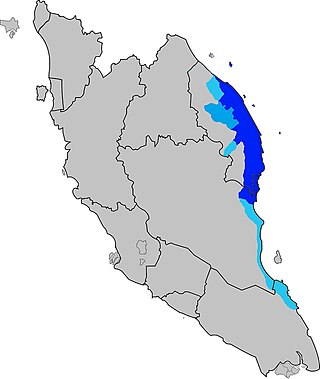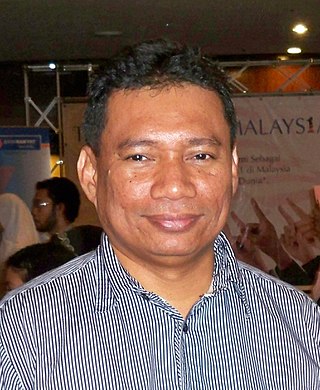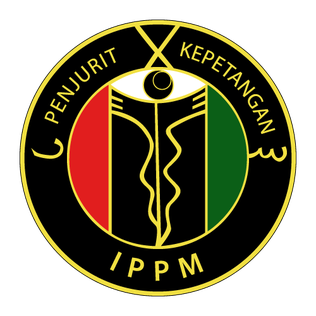
A golok is a cutting tool, similar to a machete, that comes in many variations and is found throughout the Malay archipelago. It is used as an agricultural tool as well as a weapon. The word golok is used in Indonesia and Malaysia and in the Philippines. Both in Malaysia and in Indonesia, the term is usually interchangeable with the longer and broader parang. In the Sundanese region of West Java it is known as bedog.

The Kedayan are an ethnic group residing in Brunei, Federal Territory of Labuan, southwest of Sabah, and north of Sarawak on the island of Borneo. According to the Language and Literature Bureau of Brunei, the Kedayan language is spoken by about 30,000 people in Brunei, and it has been claimed that there are a further 46,500 speakers in Sabah and 37,000 in Sarawak. In Sabah, the Kedayan mainly live in the southern districts of Sipitang and Beaufort, where they are counted as a part of the local Malay populace. Whilst in Sarawak, the Kedayans mostly reside in the towns of Lawas, Limbang and Miri.

The klewang or kelewang is a category of traditional single-edged sword that can be found throughout the Malay archipelago region in Indonesia and Malaysia. Usually it is shorter than a pedang (sword) but longer than a golok (machete). There are straight bladed types, but most are curved.
Buyong Adil was a national historian of Malaysia and author of several books on the history of Malaysia. Buyong was a nickname given by his parents. He was also known as Cikgu Buyong. He would spend his later career working in the Dewan Bahasa dan Pustaka, a government regulating body that coordinates the use of the Malay language and Malay-language literature.
Sekolah Menengah Kebangsaan Kok Lanas is a coeducational day school located in Kampung Kok Lanas, Kota Bharu, Kelantan, Malaysia.

Terengganu Malay is a Malayic language spoken in the Malaysian state of Terengganu all the way southward to coastal Pahang and northeast Johor. It is the native language of Terengganu Malays and highly localised Chinese Peranakan community as well as a second language among the smaller Indian minority. The language has developed a distinct phonetic, syntactic and lexical distinctions which makes it mutually unintelligible for speakers from outside the east coast of Peninsular Malaysia especially those who speak Standard Malay/Malaysian. Terengganu Malay still shares close linguistic ties with neighbouring Kelantan-Pattani and Pahang of which it forms under the umbrella term of "East Coast Peninsular Malayic languages". These similarities have often confused many people outside the region, who usually interchange Terengganu Malay with Kelantan Malay, even though there are major phonological and vocabulary differences between the two.
This article explains the phonology of Malay and Indonesian based on the pronunciation of Standard Malay, which is the official language of Brunei, Singapore and Malaysia, and Indonesian, which is the official language of Indonesia and a working language in Timor Leste. There are two main standards for Malay pronunciation, the Johor-Riau standard, used in Brunei and Malaysia, and the Baku, used in Indonesia and Singapore.

Syed Mohd Zakir Bin Syed Othman Al-Yahya, is a Malaysian writer of prose, poetry, and theatrical texts.

Istiadat Pewaris Penjurit-Kepetangan Melayu or formerly known as Ilmu Persilatan Penjurit-Kepetangan Melayu, shortform IPPM is one of the oldest original known to date Malay martial art form or called 'Silat' in existence which has been heritage from one generation to another. Descended from the first ruler of the Malayapura Kingdom, King Adityawarman whom is also known as Seri Maharaja Diraja which to a later stage sparked the start of Minangkabau history in Pagaruyung Kingdom, Sumatra, Indonesia. These story has been greatly narrated in most of old Malay Literature including in of the most reliable sources to date called Sulalatus al-Salatin or better known as The Malay Annals (Malay: Sejarah Melayu). The manuscript begin with the stories of Wan Malini and Wan Empuk whom was presented with 3 adopted princes right after when their rice fields was magically expelling gold. These 3 princes was later mark as the kickstart for the next 3 big empires in Malay Archipelago. Those empires were the Kingdom of Majapahit, The Malacca Sultanate and the Pagaruyung Kingdom around the 12th century.

Parang Chandong is a traditional chopper used by the Dayak people of the Baram River in Borneo.
Perak Malay is one of the Malay dialects spoken within the state of Perak, Malaysia. Although it is neither the official language nor the standard dialect in the whole state of Perak, its existence which co-exists with other major dialects in the state of Perak still plays an important role in maintaining the identity of Perak. In spite of the fact that there are five main dialects traditionally spoken in Perak, only one of which is intended by the name "Perak Malay". There are subtle phonetic, syntactic and lexical distinctions from other major Malay dialects. Perak Malay can be divided into two sub-dialects, Kuala Kangsar and Perak Tengah, named after the daerah (districts) where they are predominantly spoken.

Kelantanese Malays are a sub-ethnic group of Malays native to the state of Kelantan, Malaysia as well as in Northern Terengganu. The Kelantanese Malays are closely related to Thai Malays and Terengganuan Malays in neighbouring Terengganu, these two Malay sub-ethnic groups shared historical, cultural and linguistic as well as kinship ties with the Kelantanese Malays. Kelantanese Malays form 94% of Kelantan's population, which makes them the largest ethnic group in Kelantan and around 150,000 in Besut, Terengganu.
The Kelantan order of precedence is a nominal and symbolic hierarchy of important positions within the state of Kelantan. It has no legal standing but is used to dictate ceremonial protocol at events of a state nature.

Zakaria Ariffin is a Malaysian playwright, theater director and educator.

Bedil is a term from Maritime Southeast Asia which refers to various types of firearms and gunpowder weapons, from small pistols to large siege guns. The term bedil comes from wedil and wediluppu in the Tamil language. In their original form, these words refer to gunpowder blast and saltpeter, respectively. But after being absorbed into bedil in the Malay language, and in a number of other cultures in the archipelago, Tamil vocabulary is used to refer to all types of weapons that use gunpowder. The terms bedil and bedhil are known in Javanese and Balinese. In Sundanese the term is bedil, in Batak it is known as bodil, in Makasarese, badili, in Buginese, balili, in Dayak language, badil, in Tagalog, baril, in Bisayan, bádil, in Bikol languages, badil, and in Malay it is badel or bedil.
Dr. Mohamed Ghazali bin Abdul Rashid or better known by his pen name Malim Ghozali PK was a Malaysian writer and laureate from Perak. He was crowned as the Sasterawan Perak in 2014. He authored a variety of literary works such as Novels and short stories. He also received numerous awards including the Southeast Asian Writers Award in 2013.
Pengiran Mohammad, pen name Zairis M.S., is a Bruneian politician and writer in the Government of Brunei whole formerly took office as the second Minister of Religious Affairs from 2010 to 2015, and Deputy Minister of Education from 2005 to 2010.

The Parang Bongkok is a billhook parang that originates from Kelantan, Malaysia.

The Parang Ginah is a sickle shaped Malay cutting implement, whether a sword or a sickle is uncertain, most likely the latter.

Muslim bin Burut, pen name Muslim Burmat, was a writer from Brunei who wrote a great deal of literature, particularly novels and short stories that are used in Brunei's educational institutions. In addition to receiving numerous literary honours, his works—which are primarily realistic but also include fresh historiography—showcase aspects of Brunei society.














